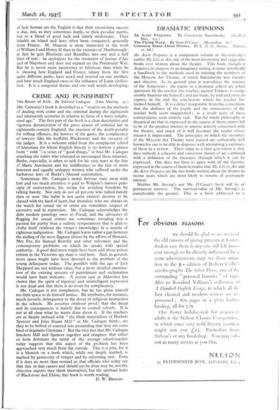CRIME AND PUNISHMENT
The Roots of Evil. By Edward Cadogan. (John Murray. 9s.)
MR. CADOGAN'S book is described as a " treatise on the methods of dealing with crime and the criminal during the eighteenth and nineteenth centuries in relation to those of a more enlight- ened age." The first part of the book is a clear description and vigorous denunciation of the gross abuses of criminal law in eighteenth-century England, the exaction of the death-penalty for trifling offences, the horrors of the gaols, the complacency of lawyers (like the ineffable Blackstone) and the savagery of the judges. It is a welcome relief from the complacent school of historians for whom English history is (to borrow a phrase from " io66 ") a series of " good things," to find Mr. Cadogan attacking the rulers who tolerated or encouraged these infamies. Burke, especially, is taken to task for his easy tears at the fate of Marie Antoinette and his indifference to the fate of more innocent and equally unhappy women who suffered under the barbarous laws of Burke's blessed constitution.
Sometimes Mr. Cadogan's moral fervour runs away with him and too much attention is paid to Walpole's famous prin- ciple of conversation, his recipe for avoiding boredom by talking bawdy. Not only do not all persons who talked bawdy then or now (the habit is not quite extinct) deserve to be classed with the hard of heart, but moralists who are always on the watch for sexual sin or crime are sometimes suspect of excessive zeal in repression. Mr. Cadogan acknowledges the debt modem penology owes to Freud, and the advocates of flogging for sexual crimes are sometimes revealing less a passion for purity than a sadistic temperament that is glad to clothe itself (without the owner's knowledge) in a mantle of righteous indignation. Mr. Cadogan leaveirather a gap between the ending of the most flagrant abuses by the efforts of Howard, Mrs. Fry, Sir Samuel Romilly and other reformers and the contemporary problems on which he speaks with special authority. A good deal more might have been said about prison reform in the Victorian age than is said here. And, in general, more space might have been devoted to the problem of the young delinquent today. The parallels with the age of Jack Sheppard are not without value, but a more detailed examina- tion of the existing systems of punishment and reclamation would have been welcome. A recent case at Aldershot has shown that the spirit of rigorous and unintelligent repression is not dead and that there is no room for complacency.
Mr. Cadogan is not complacent, but he has given himself too little space to do himself justice. He attributes, for instance, Much juvenile delinquency to the decay of religious instruction in the schools. He assumes (without proof) that the decay and its consequences is mainly due to council schools. It is not` at all clear what he wants done about it. If the teachers are as deeply imbued with " the bleak materialism of Herbert Spencer and John Stuart Mill " as Mr. Cadogan thinks, are they to be bribed or coerced into pretending that they are some kind of dogmatic Christian ? But the very fact that Mr. Cadogan brackets Mill and Spencer together and imagines that either or both dominate the mind of the average school-teacher today suggests that this aspect of the problem has been approached very much from the outside. This is a pity, for it is a blemish on a book which, while not deeply learned, is marked by generosity of temper and by reforming zeal. Even if it does no more than remind us that officials who today say that this or that cannot and should not be done may be, not the objective experts they think themselVes, but the spiritual heirs of Blackstone and Eldon, this book is worth reading.
D. W. BROGAN.










































 Previous page
Previous page